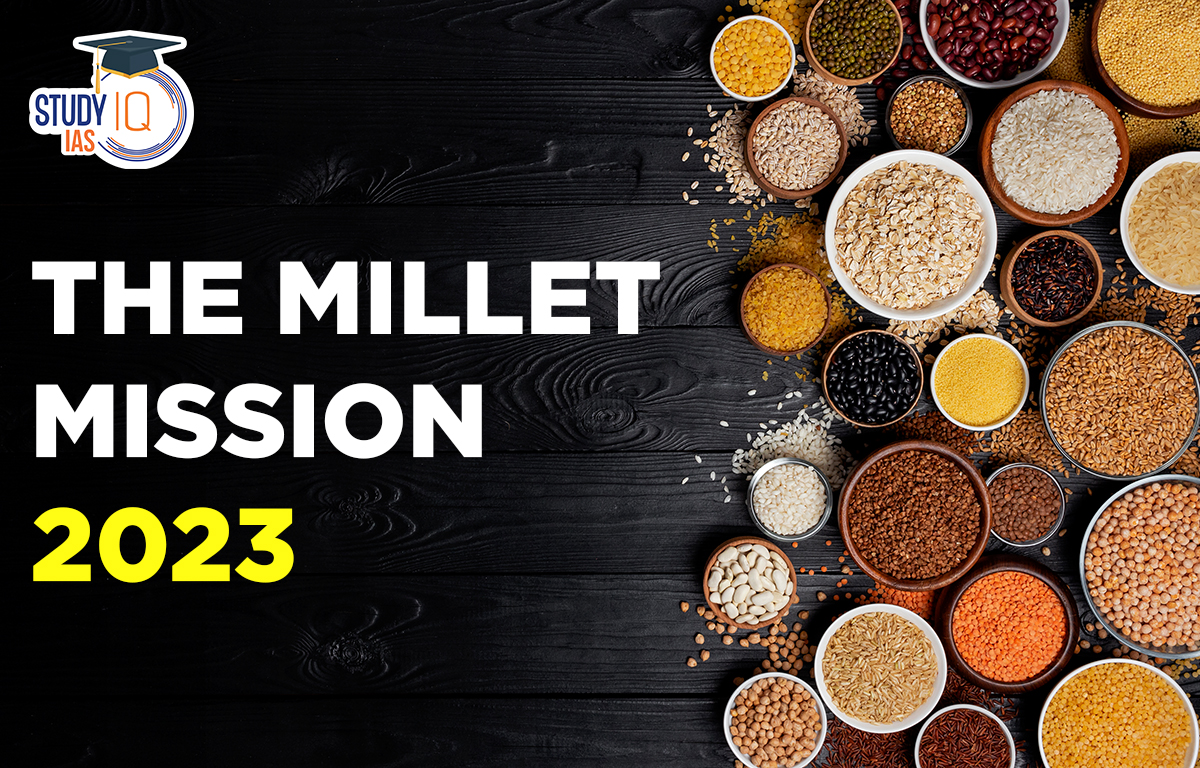Table of Contents
International Year of Millets (IYOM) 2023
- On March 3, 2021, the United Nations General Assembly (UNGA) adopted a resolution to
declare 2023 as the International Year of Millets.- The proposal was moved by India and was supported by 72 countries.
- Significance:
- IYOM will provide an opportunity to increase global production, efficient processing and better use of crop rotation and promote millets as a major component of the food basket.
- Last month, the FAO launched the IYOM in Italy and highlighted that the promotion of millets aligns with Sustainable Development Goals (SDGs) — 1, 3, 8, 12, 13 and 15.
- Political significance for India: Millet is grown mainly in low-income and developing countries in Asia and Africa, and is part of the food basket of about 60 crore people across the globe.
- By proposing the resolution to celebrate 2023 as the International Year of Millets, India pitched itself as a leader of this group.
- This is similar to the Indian initiative on the 121-nation International Solar Alliance.
About Millets
- Millets are part of a group of small-grained cereal crops used as both food and fodder. About 6,000 varieties of these grains with varying colours exist around the world.
- Historical background: They were among the first crops to be domesticated.
- There is even evidence of the consumption of millet in the Indus Valley Civilization.
- Hanging Gardens of Babylon apparently included millet among their treasured plants.
Advantages of Millets


- Global production: Presently, millets are grown in more than 130 countries and consumed as a traditional food by over half a billion people across Asia and Africa.
- Globally, sorghum (jowar) is the biggest millet crop.
- The major producers of jowar are the United States, China, Australia, India, Argentina, Nigeria, and Sudan
India and Millets
- In India, millets are mainly a kharif crop.
- Production: India is the largest producer of millet in the world with a share of 41% in 2020, as per FAO.
- Nine types are grown as kharif crops in over 20 States in the country.
- Rajasthan, Karnataka, Maharashtra and Andhra Pradesh are leading producers.
- For the year 2021-22, about 16 million tonnes millets have been produced in India, which is about 5 percent of the national food grain basket.
- Bajra has the highest market share, followed by jowar.
- MSP for Millets: The government declares a Minimum Support Price (MSP) for jowar, bajra and ragi only.
- Target for procurement: The government has set a target to procure 13.72 LMT coarse grains during the Kharif Marketing Season (KMS) 2022-23, more than double procured during KMS 2021-22.
- Main millet states: Jowar is mainly grown in Maharashtra, Karnataka, Rajasthan, Tamil Nadu,
Andhra Pradesh, Uttar Pradesh, Telangana, and Madhya Pradesh.- Bajra is mainly grown in Rajasthan, Uttar Pradesh, Haryana, Gujarat, Madhya Pradesh, Maharashtra and Karnataka.
- Consumption patterns: In the latest available NSSO household consumption expenditure survey, less than 10 per cent of rural and urban households reported consumption of millets.
- State-wise: Gujarat (jowar and bajra), Karnataka (jowar and ragi), Maharashtra (jowar and bajra), Rajasthan (bajra), and Uttarakhand (ragi).
India’s Efforts to Promote Millets
- Rebranding as ‘Nutri-Cereals’: Millets were earlier referred to as “coarse cereals” or “cereals of the poor”. The Union government renamed these as “nutri-cereals” owing to their high nutritional value.
- National year of millets: The Union government declared 2018 as the ‘national year of millets’ to trigger an increase in demand.
- Initiative for Nutritional Security through Intensive Millets Promotion (INSIMP): A sub-scheme of Rashtriya Krishi Vikas Yojana (RKVY) between 2011 and 2014. The scheme aims to catalyze increased production of millets in the country.
- Millets under PDS:
- Under the National Food Security Act (NFSA), 2013, eligible households are entitled to get rice, wheat, and coarse grain at Rs 3, Rs 2, and Re 1 per kg respectively.
- There is a need to shift the focus of distribution programs from basic calories to provide a more diverse food basket to improve the nutritional status of pre-school children and women of reproductive age.
- NFSM: Under the National Food Security Mission (NFSM), nutritious cereal component for Millets
is being implemented in 212 districts of 14 States. - POSHAN Mission: Millet has also been included under POSHAN Mission campaign.
- Start-Ups: India has more than 500 start-ups in millet value additional food chain. The
government’s Indian Institute of Millets Research has incubated 250 startups.


 Serious Fraud Investigation Office (SFIO...
Serious Fraud Investigation Office (SFIO...
 Article 142 of Indian Constitution, Sign...
Article 142 of Indian Constitution, Sign...
 Pakistan-Occupied Kashmir (PoK): History...
Pakistan-Occupied Kashmir (PoK): History...





















